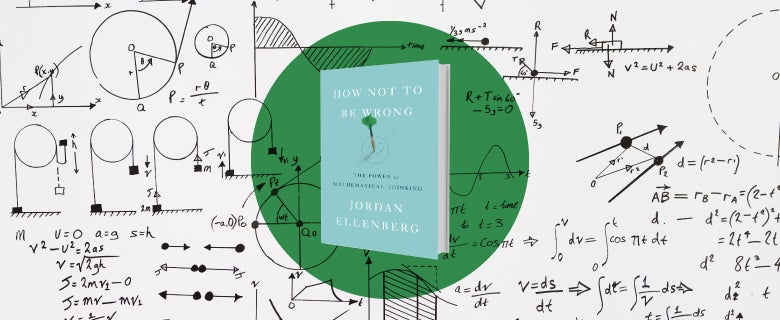In the realm of mathematics, few names resonate as profoundly as Jordan Ellenberg, PhD. A distinguished mathematician, Ellenberg has made significant contributions to number theory and algebraic geometry. However, his influence extends far beyond academia. As the author of “How Not to Be Wrong: The Power of Mathematical Thinking,” Ellenberg has revolutionized how we perceive and utilize mathematics in our daily lives. This article is an effort to bridge the gap between abstract mathematical concepts and their practical applications in everyday life for Indian students and teachers.
Math in Daily Life
Do you know how often you use math in your daily life? It’s fascinating how it weaves into everyday decisions, thoughts, and experiences. This kind of math doesn’t require high-level calculus or complicated theories; it’s the ordinary math we come across without realizing it.
Have you ever compared prices while shopping at local markets like Sarojini Nagar or Dilli Haat? That’s math. How about when you’re figuring out the fastest route to work or school through the crowded streets of Delhi or Mumbai? That’s also math. Even your decision-making process involves mathematical thought, such as weighing the pros and cons of buying vegetables from the street vendor or the supermarket. Here, you will find simple, easy-to-understand examples of these everyday occurrences.
This summary will also examine how percentages and probabilities influence the perception of discounts and deals, such as during the festive seasons of Diwali or Holi. Moreover, these figures aren’t limited to chance-based games but form the backbone of everyday risk assessment, like deciding the best time to leave home to avoid traffic jams.
Consider how math helps you make sense of trends and patterns, whether in weather forecasts during the monsoon season or stock market fluctuations reported in The Economic Times. Basic mathematical principles extend their reach into your personal finances, guiding you toward more informed decisions about saving and spending.
Math is a tool everyone can use with a little understanding and practice. Each section unfolds with real-life examples, illustrating math’s application within relatable scenarios. As you progress, you’ll start recognizing the mathematics already interwoven into your daily routine, allowing you to utilize it more effectively.
By the end of this journey, you’ll develop a newfound appreciation for math’s role in your everyday life. It won’t be a daunting subject but a valuable tool for making better decisions, understanding the world, and enjoying life’s little puzzles.
Consider this your invitation to unravel the hidden math in your daily life. Regardless of your relationship with numbers, whether you love them or are a bit wary, this story is crafted just for you.

Analyze Datasets with Noise in Mind
In mathematics, noise is any unwanted modification that interrupts your dataset.
When the sample size is small, the noise level tends to be high, making its information unreliable. For instance, let’s say the CBSE collects academic data on students. In that case, it is possible to reach an incorrect conclusion if many schools are not considered. By randomly selecting a handful of schools, the data will use the quality of students in the schools chosen to represent the entire region. Thus, the dataset will only be accurate if it reflects the region, including high and low-performing institutions.
The best way to approach these situations is to gather sufficient data from all regional schools and take the average—this will be more representative than choosing a small sample size.
When interpreting percentages mathematically, it’s crucial to ensure there are no negative numbers. Percentages are most effective when applied to positive quantities, though they can be misleading when applied to profit and loss. A more accurate understanding may be obscured by average ratios over an extended period, revealing nuances hidden behind sudden spikes in positive percentages.
Averaging random numbers can help you make informed decisions. Humans possess a knack for spotting patterns, even in randomness. With a large dataset, the temptation to see false repetition increases, so developing a null hypothesis is essential. It’s a statistical theory that assumes no relationship between variables exists until proven otherwise. The p-value measures the likelihood of an event becoming a pattern. If it dips below 5%, there is a pattern. If not, it is random.
For example, some believe blowing on a die before rolling makes it more likely to roll a six. It might have worked a few times, but that doesn’t establish a pattern. A principle gains credibility only if anyone can predictably replicate the results.

Risk is Better Than Uncertainty
Have you ever thought about the distinction between risk and uncertainty in decision-making? Risk is measurable and manageable, while uncertainty is less predictable and more challenging to quantify. Let’s take an example of a bag filled with 90 balls of three colors: red, yellow, and black. Knowing there are 30 black balls allows you to calculate the risk of not selecting one of them as two-thirds. However, uncertainty arises when the quantity of red or yellow balls remains to be determined.
Dealing with risks is preferable because they allow for planning and preparation. In finance, investors gauge the risk of their investments using historical data from sources like the NSE or BSE. They can calculate the probability of gains or losses based on past performance; this helps them make more informed decisions about where to put their money.
On the other hand, uncertainty is like wandering in the dark, where unforeseen obstacles may emerge. As a result, they can lead to significant losses, especially when they go unrecognized or unacknowledged. For instance, a business might face uncertainty about future market trends or consumer preferences. These are not easily measurable and can significantly affect the company’s success.
Furthermore, it’s essential to recognize that while algorithms are helpful, they’re not foolproof, especially in predicting human behavior. Algorithms are based on data, and their predictions can be flawed if that data is incomplete or biased; this is particularly true in scenarios involving complex human behaviors, where there are many variables that an algorithm might need to account for.
While risks can be quantified and managed, uncertainties are much harder to predict and control.

Why Are People Afraid of Big Data?
Many fear big data because algorithms can use them to make better inferences than humans. For example, a marketing analytics company might predict consumer behavior based on data trends, sometimes raising privacy concerns.
Yes, more data may increase the accuracy of inference by algorithms in some fields, but this assumption does not apply to all cases. Data can help you predict an asteroid’s path, but it may not forecast the weather correctly. The weather is chaotic; a small event on one side of the globe can ripple into significant changes elsewhere. Human behavior shares a similar unpredictability.
The unpredictability of human activities makes it extremely difficult to develop a model or an algorithm to predict choices.
Here’s a story to illustrate how hard it is to predict human behavior:
In 2006, Netflix launched a million-dollar competition, inviting anyone to craft a more accurate algorithm for suggesting movies. Armed with access to vast datasets, contestants toiled for three years, only reaching a modest 10% improvement. It took a collaborative effort from multiple teams to reach that milestone. Despite the progress, perfection remained elusive. The lesson is that big data doesn’t provide an accurate picture of human actions. We are more intricate than we imagine.
However, it doesn’t mean prediction models and algorithms aren’t helpful. We shop quickly on Amazon, fill our social media timelines with content we love, and use GPS and other tech products, thanks to intelligent algorithms.
These benefits don’t just apply to giant tech companies; embracing mathematical thinking allows you, whether an individual or organization, to discern the boundaries of your predictive capacity. It compels you to pose questions that unveil holes in your formulas or reasoning.
Foster Progress Through Continuous Inquiry
If you want to make genuine strides, keep questioning your beliefs—this is a crucial aspect of thinking like a mathematician. Let’s look at this idea in more detail, using examples from history and everyday life.
Consider how mathematician Ramanujan’s unconventional approach to mathematics led to groundbreaking discoveries. Instead of conforming to prevailing opinions, he dared to ask different questions and view problems uniquely.
Then there’s the story of Jordan Ellenberg, a college intern who attempted to predict the number of people with tuberculosis by 2050. He worked hard on the math but realized it was impossible to be sure. Even when pressured for a specific number by his boss, Ellenberg knew too many things could change, and any number he gave would need to be corrected.
This practice of continuously asking questions is for more than just big scientific or math problems. It’s valid for everyone deciding how to spend their money, planning their future, or dealing with friends and family. When you keep questioning your ideas, you can make better choices.
In business, bosses who revisit and reassess their plans can manage changes better and develop new ideas. In your own life, questioning what you believe can help you grow as a person and improve your relationships. Admittedly, this process demands effort. People might not like it when you challenge what they think is true, but it takes bravery and honesty to ask these tough questions. As a result, embracing this mindset fosters continual learning and improvement in every aspect of your life.

The Simplicity of Math
Math can seem hard at first, but once you understand it, it’s pretty cool. People often ask, “Why do we need to learn all this math when we don’t use it in real life?” Well, think of math as an exercise for your brain. While you might not apply such complex equations daily, learning them keeps your brain sharp. It’s like how a cricket player trains—they don’t just play cricket all the time; they do different exercises to enhance their performance on the field.
Math isn’t just about numbers and formulas; it involves thinking logically.
It teaches you how to connect the dots between different ideas and make informed decisions. When evaluating whether an idea makes sense, math is a valuable tool to test its validity.
In math, navigating through the nuances of information is crucial. Let’s say you are looking for the best school in your area. Browsing just a few offers will only give an incomplete picture, similar to imagining what a puzzle will look like with just a few pieces. To grasp the complete perspective, you need to examine multiple schools.
Math plays a role in the things we use every day. For instance, you use math to calculate your change when making a purchase or to measure ingredients when you cook.
The Impact of Mathematical Thinking on Personal Finance
When it comes to handling money, math is handy. It’s not just about solving complicated problems; it’s about applying simple math concepts to make better financial decisions.
Let’s start with budgeting, a fundamental aspect of money management. While many may think budgeting is just about expense tracking, it also involves planning and dividing your income into necessities, wants, and savings. By doing so, you’re not just watching where your money goes; you’re strategically saving for the future.
Additionally, understanding sales and discounts requires some mathematical finesse. When you learn how to calculate percentages quickly, it is easier to determine whether a deal really is as good as it seems. It’s a simple skill but can save you lots of money in the long run.
You can take control of your finances and plan for a better future with mathematical thinking.
Now, let’s talk about loans and interest rates. While they may seem complicated, they play pivotal roles in significant financial decisions, like buying a car or a house. To calculate the total amount of your debt, you need to understand how interest works. It helps you see the actual cost of borrowing money and how seemingly modest interest rates can accumulate over time.
Investing is another area where math plays a significant role. It might seem daunting, but at its core, it’s about understanding your money’s growth potential over time.
Concepts like compound interest, where you earn interest on both the money you save and the interest you’ve already earned, are how to understand how investments work. Even a basic grasp of these ideas allows you to make savvy choices about where to invest your hard-earned money.
Saving for the future, whether it’s for retirement or a big trip, is another arena where math proves its reliability. By calculating how much you need to save each month and foreseeing how your savings will grow over time, you can set goals and make sure you’re on track to meet them.
Finally, let’s address the elephant in the room—debt. It’s all too easy to plunge into debt through credit cards or loans, but getting out of it can be a struggle. Understanding how interest accumulates on your debt and how repayments work can help you pay off your debt faster and avoid paying more than you must.
Conclusion
Math is a tool that helps us make better choices in life. It starts with simple truths, like two plus two equals four. However, the beauty of math extends beyond mere addition. It’s a mental gym where we flex our brains and navigate through tricky puzzles, much like the ones famous mathematicians tackle. You might think this has nothing to do with everyday life, but it does.
There’s a special kind of math that is both easy to understand and profoundly impactful. It combines various mathematical concepts to help us figure out real-world problems and reminds us that uncertainty is not a hindrance but an ally. For example, in elections, math can show how likely each person is to win, allowing us to make an informed decision.
Math is a way of thinking that helps us in life. It teaches us that uncertainty is a natural part of decision-making, encouraging us to carefully consider every option and outcome. In this context, numbers serve as transparent windows into our choices, helping us to proceed with clarity. In essence, math isn’t confined to the classroom; it’s a companion that enriches our daily lives.
Try This
- Explore all your options: Assess whether you’ve weighed all your options. Sometimes, there are more solutions to a problem than you realize.
- Imagine the opposite: Consider what would happen if you reversed your initial choice. This perspective shift helps you see things from a different angle.

